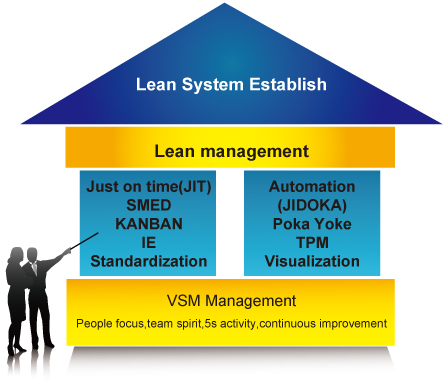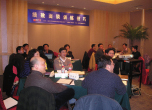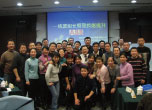|
|
 |
|
 |
Lean production was originated in the Toyota Production System (TPS).The purpose of lean production is to realize the objective of ¡°cutting costs, eliminating wastes and deriving maximum output from minimum input¡±. The lean production system takes ¡°relentless pursuit of excellence¡± as a business objective and pursues continuous improvement in product quality, cost and service. This philosophy is the mental force driving lean production towards success. The success of lean production is not the result of applying a couple of new management techniques but the outcome of applying a series of lean production techniques and tools on an ongoing basis.
|
|
BESTWAY Management Consultants Co., Ltd. has since its inception been dedicated to promoting the application of lean manufacturing systems in manufacturing enterprises and helping them boost productivity, improve staff quality and enhance profitability by implementing the lean production system. The series courses represent the multiyear experiences of BESTWAY in providing lean production training coaching services for corporate clients. We hope there will be more enterprises benefiting from these courses. Lean production is a goal to be pursued relentlessly. We wish to work together with you to move relentlessly towards realizing this goal.
|
|
|
The primary purpose of lean production is to realize extremely high productivity, excellent production quality and great production flexibility in an enterprise. To realize this purpose, the production system must be built upon a solid basis and structure. The overall system of lean manufacturing is shown below:
|
 |
|
| This training course consists of all essential qualifications on the following three aspects: |
 |
|
| Module |
Serial Number |
Course Name |
Time or Day |
| Lean Basics |
1 |
Lean Production Basis |
2 |
| 2 |
Onsite 5S and Visual Management |
2 |
| Lean Tools |
3 |
Administrative Office 5S |
1 |
| 4 |
Value Stream Mapping and Improvement |
1 |
| 5 |
Total Productive Maintenance (TPM)
|
2 |
| 6 |
Single Minute Exchange of Die (SMED)Exchange of Die |
1 |
| 7 |
IE Improvement |
2 |
| Lean Expert |
8 |
POKA YOKE |
1 |
| 9 |
JIT and Kanban |
2 |
| 10 |
Lean Supply Chain |
2 |
|
|
| 1¡¢Lean Production Basis |
| In this course, the trainer will make a thorough presentation of lean production. As a result, the participants will learn the history, general principles and key points of lean production and gain full mastery of lean production techniques. After the completion of this course, the participants should be able to better understand some practices currently adopted in the lean production process; change their conventional notions and proactively discover, analyze and solve problems under lean thinking mode. |
• Lean production overview
• Thinking systems and three methodologies
• value added and non-value added
• Seven major wastes onsite
• 5S activities |
• Total Productive Maintenance (TPM)
• Kanban production
• Basic methods of onsite improvement
• Other improvement methods
|
|
| 2¡¢Onsite 5S and Visual Management |
| 5S is one of the indispensable activities in modern management. Visual factories are more conducive to onsite management improvement and productivity increase. After the completion of this course, the participants should be able to learn: how to identify and eliminate wastes; improve their working environment; share information and rapidly discover and prevent problems using visual management techniques; help staff members self-manage and support your company¡¯s continuous improvement activities. |
• Introduction to 5S and visual management
• Areas of improvement
• Action plan and resource allocation
• Factory identification and color code |
• Visual standards for information exchange
• Formulate 5S implementation methods
and evaluation standards |
|
| 3¡¢Administrative Office 5S |
| Administrative office 5S is one of the bases underpinning a lean enterprise. The purpose of this course is to help your company or enterprise understand the principles and methods of 5S and why an enterprise needs to implement 5S. The course is intended to help the participants gain an in-depth understanding of the principles and tools of administrative office 5S and learn how to apply them in their daily work; thus rapidly boost administrative efficiency, reduce error rates and quickly merge administrative support teams into the lean enterprise revolution process. |
• Impact of administrative office 5S on corporate culture
• Relationship between office 5S and lean production
• identify and eliminate 7 wastes in the administrative
process
• Office 5S implementation procedures and tools |
• How to use red cards
• How to effectively manage office supplies
• 5S team improvement activities |
|
| 4¡¢Value Stream Mapping and Improvement |
| Value stream mapping is one of the systematic improvement tools widely used by European and American firms. It enables you to ¡°see¡± the material flow and information flow from order placement to product delivery. By way of current status analysis and future prospect planning, you can identify and eliminate wastes, realize flow and customer-driven balanced production and eventually realize the goal of systematic improvement. |
• Manufacturing systems status mapping and
improvement
• Set Takt Time and eliminate bottlenecks
• Continuous flow plan (Group site tour and discussion)
• Kanban pull and materials supermarket planning
(Group site tour and discussion)
|
• Balanced production methods and control
point selection
• Target planning and indicator system
• Manufacturing system assessment (Group
discussion and report) |
|
| 5¡¢Total Productive Maintenance (TPM) |
| This course enables the participants to understand how to apply the systematic tools of TPM and learn how to do team work and share experiences and improvement results so that they can set up a suitable TPM system for your enterprise by leveraging role model effects. TPM fundamentally changes the traditional management model underwhich ¡°You Maintain, I Operate¡± and move closer towards realizing the goals of zero fault, zero defect/zero accident and minimum product life cycle. |
• Introduction to TPM (definition, targets, OEE
analysis and calculation)
• Inspect the site, observe machines and take
pictures of them before improvement
• Improvement Notice, experience sharing, and WHY-WHY
|
• Skills training and implementation procedures
• Site (formulate improvement plan and take
post-improvement pictures)
• TPM measurement standards
|
|
| 6¡¢Single Minute Exchange of Die (SMED) |
Single Minute Exchange of Die (SMED) is a useful technique developed by Toyota to handle multi-lot and small-lot
production, reduce inventory and boost the rapid response ability of the production system. The purpose of thiscourse is to introduce the 8-step fast changeover method and apply it at the workshop in order to guide the participants to systematically analyze and solve problems, set targets and realize rapid changeover within a short time and promote an improvement culture of taking immediate action. |
• Introduction to SMED (definition, targets, first steps
of the 8-step method)
• Set up groups, assign roles, inspect the site and
observe machines
• Observe the changeover process and record the
time and wastes |
• Work out the rapid changeover form
• Onsite improvement: Make job preparation,
train staff members
• implement new standards, observe and
record results,and rectify the procedure |
|
| 7¡¢IE Improvement |
| The purpose of this course is to boost productivity using IE techniques and enable managers with no IE background to rapidly acquire IE management skills; effectively employ IE techniques onsite and set new productivity record; eliminate improper working processes, motion wastes, equipment wastes and human wastes. These are the competence and skills you can acquire from this course. |
• IE overview
• Material flow analysis
• Facility or equipment planning
• Operator performance management
• Set standard time |
• Improve motion efficiency
• Develop skilled workers
• U-shaped production line balance
• Key performance indicators of production systems |
|
| 8¡¢Poka Yoke |
As one of the lean production tools, Poka Yoke helps staff identify defect-reduction opportunities. The main ideas of
Poka Yoke are: ¡°Mistakes are predictable; we can do things right the first time and continue to do so all the time.¡± The purpose of this course is to help the participants improve their capability of identifying defects and preventing mistakes and increase efficiency and quality using the systematic mistake proofing concepts and tools. |
• Defect and mistake
• Common productive mistakes
• Committing mistakes versus preventing mistakes
(Poka Yoke)
• Inspection and Poka Yoke |
• Four levels of Poka Yoke
• Poke Yoke steps
• Poka Yoke tools
• Poka Yoke devices
• Examples of defect prevention and
improvement effects |
|
| 9¡¢JIT and Kanban |
Kanban is a visual information transmission and material flow control technique. The Kanban system is characterized
by balanced material flow, rapid feedback and process synchronization. Kanban is one of the panaceas for Toyota to
pursue zero inventory and realize multi-variety and small-lot production. The purpose of this course is to introduce the characteristics and working principles of the JIT Kanban system and to enable the participants to grasp Kanban system setup and application techniques through real-world practice.
|
• Pull and push systems
• JIT material distribution targets
• Push/pull comparison
• Kanban types and working principles
• Eliminate obstacles likely to be encountered in the
Kanban implementation process |
• Kanban versus supermarket pull, inventory
reduction and flow acceleration
• Standard operation
• Participatory management
• Balancing and synchronization
• Delivery pull, production pull and external pull
• Kanban checklist |
|
| 10¡¢Lean Supply Chain |
| The purpose of this course is to present an in-depth analysis of the internal and external supply chain models and their characteristics; enable each participant to grasp internal supply chain setup and management methods in the modern manufacturing industry; allow every participant to understand and grasp the advanced enterprise operation and management methods and the advanced logistics and supply chain management techniques; and share the success stories of internationally and domestically renowned companies in implementing lean supply chain management to reduce costs and maximize profits. |
• Lean supply chain elements
• Analyze the internal supply chain of a factory
• Analyze the internal supply chain models of
different actories
• How to reasonably formulate internal production plan
• Abnormity-induced plan change skills
• Lean internal supply chain management models |
• Characteristics and implementation steps of
the pull
• production model
• Make or buy under the supply chain
management environment
• Order execution and product delivery
• Analyze losses from the external supply chain |
|
|
|
 |
The JIT production concept mentioned in this course is exactly what we need at the present time. This course enables us to understand the JIT production concept and the five principles of JIT production. In this course, we obtained enormous benefits from value stream analysis and U-shaped production line. In addition, we have changed the traditional concepts entrenched in our factory.
--United Automotive Electronic Systems Co., Ltd. |
|
 |
This course enables us to systematically understand the concepts and contents of TPM, learn the technical terms of TPM and the related calculation formulas and gain valuable insight into the actual implementation and realization of TPM.
--GE Hydro Asia Co., Ltd |
|
 |
This course delivers clear messages and rich contents. As a result of this training, I have understood the relation of SEIRI and SEITON to factory image, product quality and profitability. This course has moved our company up one notch.
--KONE Elevator |
|
|
 |
|


